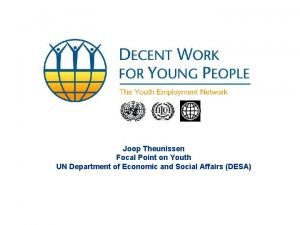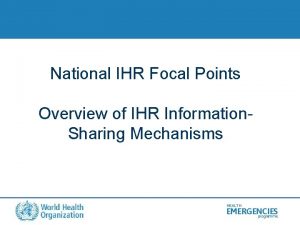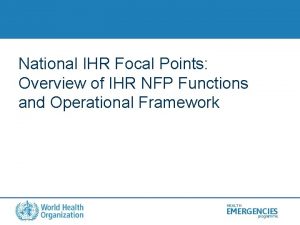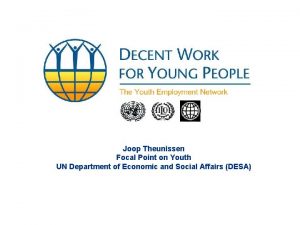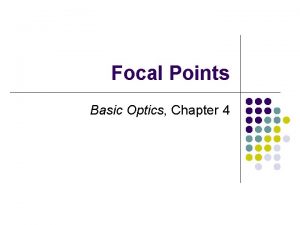Joop Theunissen Focal Point on Youth UN Department




















- Slides: 20

Joop Theunissen Focal Point on Youth UN Department of Economic and Social Affairs (DESA)

This presentation The challenge of youth employment Action for youth employment: the Youth Employment Network

The Challenge of Youth Employment

Why is YE so important? Youth is a period of transition and vulnerability Vulnerability appears to increase with globalization and increased competition, everywhere Long periods of unemployment have a lasting impact on youth: – Individual level: self-esteem, respect, sense of achievement – Societal: integration, cohesiveness, citizenship

The Present 88 million young people out of work 59 million kids (17 -19) in hazardous work Youth are 41 percent of all unemployed Youth unemployment 2 -3 times higher than average unemployment Source: ILO Key Indicators of the Labour Market, www. ilo. org/kilm. Figures for 2004.

The Best-Educated Generation Ever!* Yet… still large differences globally: 130 million children not in school 133 million youth are illiterate Large gender differences Large differences between groups of countries *(And healthiest ever too. )

Education in developing countries % Reach Grade 5 Enrolment in secondary school, M-F Adult literacy rate, M-F Sub-Saharan Africa 61 26 -22 69 -54 Middle East / North Africa 91 67 -62 75 -54 South Asia 59 57 -40 66 -40 World average 77 66 -61 85 -74

Educational inequalities in developed countries We can measure and compare the educational “baggage” of young people: Reading literacy of 15 year-olds Math literacy of 15 year-olds Science literacy of 15 year-olds Math achievement of 8 th graders Science achievement of 8 th graders

An educational achievement league of 24 rich countries The Top 5 Other countries 1 Republic of Korea 1. 4 12 France 12. 6 2 Japan 2. 2 18 USA 16. 2 3 Finland 4. 4 19 Germany 17. 0 4 Canada 5. 0 21 Spain 18. 6 5 Australia 6. 2 22 Italy 20. 2 The table shows average ranks of all five measures. Source: UNICEF Innocenti Report Card No 4, November 2002.

The Future Over 1 billion young people in need of jobs every 10 years = 100 million jobs a year 130 million kids not in school now -> what will they be in 10 years? (Importance of MDGs) More unemployed young people in urban areas with little hope for decent work Globalization –> increased competition between young people in more countries?

2. The Youth Employment Network (YEN)

A little history Millennium Report of the Secretary-General, 2000: The Millennium Development Goals (MDGs) Goal 8. Developing global partnerships for development, including a network to address decent and productive work for young people A high-level panel of advisers to the Secretary -General with support of three organizations: World Bank, ILO and UN

YEN’s 4 E’s to address youth unemployment 1. Employability – investing in education 2. Equal opportunities – for men and women 3. Entrepreneurship – start and run businesses 4. Employment creation – as part of macroeconomic policy

The First E. Employability n Definition: a key outcome of education and training to instill skills, knowledge and competencies of workers n Reality: high cost of investment, skills mismatch n Invest in life skills, life-long learning, ICT, entrepreneurship, SSEs in and out of school

The Second E. Equal opportunities for young men and women Before school: equal access and entry for boys and girls n In school: “tracking” out of TVE, career guidance, double burdens, cultural barriers, gender stereotyping, harassment n After school: credit access, lower skills n In the job: discrimination in pay, training, promotion n

The Third E. Entrepreneurship n n n Cultural attitudes: negative perceptions of entrepreneurship, corruption, social entrepreneurship Education: a system that stimulates entrepreneurial spirit, teachers’ training Skills training: career training, ICT Business support: skills and services to run your own firm Regulation: taxes, laws and burocracy Finance: youth as risky investments

The Fouth E. Employment creation n Yes, it is the economy that creates jobs! n n n Labour market policies Macro-economic policies Exchange rate policies Sectoral policies External economic shocks, disasters and wars Institutional support for youth employment: governance, national employment strategy, monitoring

What’s next: National action plans for youth employment by March 2004 Mobilizing financial resources for youth employment Linking youth employment with education Expanding on youth participation in policy and action: “No decision making without youth participating”

Unemployment is the problem. Youth are the solution.

Thank you! www. ilo. org/yen
 Joop theunissen
Joop theunissen Redactiesommen volwassenen
Redactiesommen volwassenen Joop woortman
Joop woortman Joop voortman
Joop voortman Joop meijer angeren
Joop meijer angeren Joop berding
Joop berding Gef operational focal points
Gef operational focal points This refers to the inner terminus of a fingerprint pattern.
This refers to the inner terminus of a fingerprint pattern. Focal point emphasis
Focal point emphasis National ihr focal point
National ihr focal point Lens
Lens Where is the focal point in a triangular arrangement
Where is the focal point in a triangular arrangement All customers are served from a single focal serving point
All customers are served from a single focal serving point Beach ball earthquake
Beach ball earthquake Schelling points
Schelling points Focal point poe
Focal point poe The first element the eye sees; the focal point
The first element the eye sees; the focal point The first element the eye sees; the focal point
The first element the eye sees; the focal point Triangular arrangement
Triangular arrangement Department of youth and community development
Department of youth and community development Nyc department of youth
Nyc department of youth
